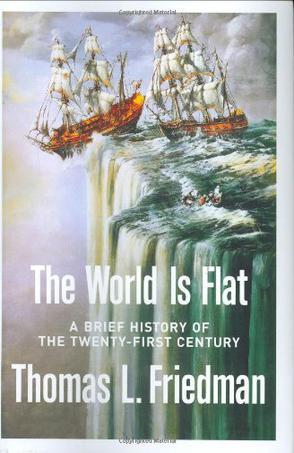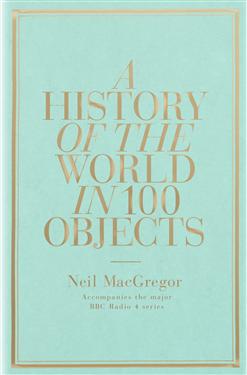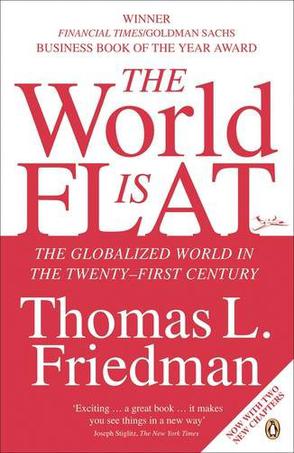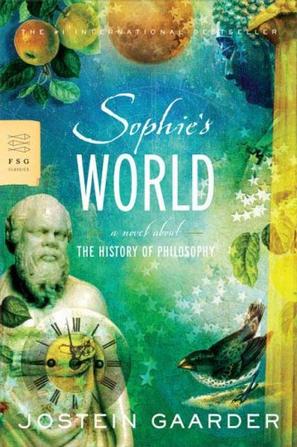欢迎来到相识电子书!
标签:world
-
The World Is Flat
In this brilliant new book, the award-winning New York Times columnist Thomas Friedman demystifies the brave new world for readers, allowing them to make sense of the often bewildering global scene unfolding before their eyes. With his inimitable ability to translate complex foreign policy and economic issues, Friedman explains how the flattening of the world happened at the dawn of the twenty-first century; what it means to countries, companies, communities, and individuals; and how governments and societies can, and must, adapt. The World Is Flat is the timely and essential update on globalization, its successes and discontents, powerfully illuminated by one of our most respected journalists. -
Shanghai's Dancing World
This book looks into a relatively ignored yet interesting aspect of Shanghai's social history. Drawing upon a unique and untapped reservoir of newspapers, magazines, novels, government documents, photographs and illustrations, this book traces the origin, pinnacle, and ultimate demise of a commercial dance industry in Shanghai between the end of the First World War and the early years of the People's Republic of China. Delving deep into the world of cabarets, nightclubs, and elite ballrooms that arose in the city in the 1920s and peaked in the 1930s, the book assesses how and why Chinese society incorporated and transformed this westernized world of leisure and entertainment to suit their own tastes and interests. Focusing on the jazz-age nightlife of the city in its "golden age," the book examines issues of colonialism and modernity, jazz and African-American culture, urban space, sociability and sexuality, and latter-day Chinese national identity formation in a tumultuous era of war and revolution. -
A History of the World in 100 Objects
'In this book, we travel back in time and across the globe, to see how we humans have shaped our world and been shaped by it over the past two million years. The story is told exclusively through the things that humans have made - all sorts of things, carefully designed and then either admired and preserved or used, broken and thrown away. I've chosen just a hundred objects from different points on our journey - from a cooking pot to a golden galleon, from a Stone Age tool to a credit card, and each object comes from the collection of the British Museum' - [from the introduction]. This book takes a dramatically original approach to the history of humanity, using objects which previous civilisations have left behind them, often accidentally, as prisms through which we can explore past worlds and the lives of the men and women who lived in them. The book's range is enormous. It begins with one of the earliest surviving objects made by human hands, a chopping tool from the Olduvai gorge in Africa, and ends with an object from the 21st century which represents the world we live in today. Neil MacGregor's aim is not simply to describe these remarkable things, but to show us their significance - how a stone pillar tells us about a great Indian emperor preaching tolerance to his people, how Spanish pieces of eight tell us about the beginning of a global currency or how an early Victorian tea-set tells us about the impact of empire. Each chapter immerses the reader in a past civilisation accompanied by an exceptionally well-informed guide. Seen through this lens, history is a kaleidoscope - shifting, interconnected, constantly surprising, and shaping our world today in ways that most of us have never imagined. An intellectual and visual feast, it is one of the most engrossing and unusual history books published in years. -
The World Without Us
A penetrating, page-turning tour of a post-human Earth In The World Without Us, Alan Weisman offers an utterly original approach to questions of humanity’s impact on the planet: he asks us to envision our Earth, without us.In this far-reaching narrative, Weisman explains how our massive infrastructure would collapse and finally vanish without human presence; which everyday items may become immortalized as fossils; how copper pipes and wiring would be crushed into mere seams of reddish rock; why some of our earliest buildings might be the last architecture left; and how plastic, bronze sculpture, radio waves, and some man-made molecules may be our most lasting gifts to the universe.The World Without Us reveals how, just days after humans disappear, floods in New York’s subways would start eroding the city’s foundations, and how, as the world’s cities crumble, asphalt jungles would give way to real ones. It describes the distinct ways that organic and chemically treated farms would revert to wild, how billions more birds would flourish, and how cockroaches in unheated cities would perish without us. Drawing on the expertise of engineers, atmospheric scientists, art conservators, zoologists, oil refiners, marine biologists, astrophysicists, religious leaders from rabbis to the Dali Lama, and paleontologists---who describe a prehuman world inhabited by megafauna like giant sloths that stood taller than mammoths---Weisman illustrates what the planet might be like today, if not for us.From places already devoid of humans (a last fragment of primeval European forest; the Korean DMZ; Chernobyl), Weisman reveals Earth’s tremendous capacity for self-healing. As he shows which human devastations are indelible, and which examples of our highest art and culture would endure longest, Weisman’s narrative ultimately drives toward a radical but persuasive solution that needn't depend on our demise. It is narrative nonfiction at its finest, and in posing an irresistible concept with both gravity and a highly readable touch, it looks deeply at our effects on the planet in a way that no other book has. -
Sophie's World
《苏菲的世界》一书以小说的形式,通过一名哲学导师向一个叫苏菲的女孩传授哲学知识的经过,揭示了西方哲学发展的历程。由前苏格拉底时代到萨特,以及亚里士多德、笛卡儿、黑格尔等人的思想都通过作者生动的笔触跃然纸上,并配以当时的历史背景加以解释,引人入胜。评论家认为,对于那些从未读过哲学课程的人而言,此书是最为合适的入门书,而对于那些以往读过一些哲学而已忘得一干二净的人士,也可起到温故知新的作用。 14岁的少女苏菲不断接到一些极不寻常的来信,世界像谜团一般在她眼前展开。在一位神秘导师的指引下,苏菲开始思索,她运用少女天生的悟性与后天知识,企图解开这些谜团。然而,事实真相远比她所想的更怪异、更离奇…… 《苏菲的世界》,是智慧的世界,梦的世界。它将会唤醒每个人内心深处对生命的赞叹与对人生终极意义的关怀与好奇。 Book Description A page-turning novel that is also an exploration of the great philosophical concepts of Western thought, Sophie’s World has fired the imagination of readers all over the world, with more than twenty million copies in print. One day fourteen-year-old Sophie Amundsen comes home from school to find in her mailbox two notes, with one question on each: “Who are you?” and “Where does the world come from?” From that irresistible beginning, Sophie becomes obsessed with questions that take her far beyond what she knows of her Norwegian village. Through those letters, she enrolls in a kind of correspondence course, covering Socrates to Sartre, with a mysterious philosopher, while receiving letters addressed to another girl. Who is Hilde? And why does her mail keep turning up? To unravel this riddle, Sophie must use the philosophy she is learning—but the truth turns out to be far more complicated than she could have imagined. Amazon.com Wanting to understand the most fundamental questions of the universe isn't the province of ivory-tower intellectuals alone, as this book's enormous popularity has demonstrated. A young girl, Sophie, becomes embroiled in a discussion of philosophy with a faceless correspondent. At the same time, she must unravel a mystery involving another young girl, Hilde, by using everything she's learning. The truth is far more complicated than she could ever have imagined. From Publishers Weekly This long, dense novel, a bestseller in the author's native Norway, offers a summary history of philosophy embedded in a philosophical mystery disguised as a children's book-but only sophisticated young adults would be remotely interested. Sophie Amundsen is about to turn 15 when she receives a letter from one Alberto Knox, a philosopher who undertakes to educate her in his craft. Sections in which we read the text of Knox's lessons to Sophie about the pre-Socratics, Plato and St. Augustine alternate with those in which we find out about Sophie's life with her well-meaning mother. Soon, though, Sophie begins receiving other, stranger missives addressed to one Hilde Moller Knag from her absent father, Albert. As Alberto Knox's lessons approach this century, he and Sophie come to suspect that they are merely characters in a novel written by Albert for his daughter. Teacher and pupil hatch a plot to understand and possibly escape from their situation; and from there, matters get only weirder. Norwegian philosophy professor Gaarder's notion of making a history of philosophy accessible is a good one. Unfortunately, it's occasionally undermined by the dry language he uses to describe the works of various thinkers and by an idiosyncratic bias that gives one paragraph to Nietzsche but dozens to Sartre, breezing right by Wittgenstein and the most influential philosophy of this century, logical positivism. Many readers, regardless of their age, may be tempted to skip over the lessons, which aren't well integrated with the more interesting and unusual metafictional story line. Author tour. From School Library Journal YA?From the opening Goethe quotation to the closing discussion of the big bang theory, this is an extraordinary, exciting, provocative book that has been a bestseller in Europe. Gaarder presents a didactic history of philosophical thought as part of a fictional mystery story that both pulls readers along and breaks up the "heavy" explanations into manageable parts. Yet the plot is itself a philosophical conundrum, not resolved until the aftermath of a hilarious, disturbing garden party in celebration of both Midsummer's Eve and the 15th birthday of the protagonist, a suburban Norwegian teenager. And even then, the mystery, like the human mystery, is not really resolved, and leaves readers wanting to know more. Gaarder pulls off the difficult feat of blending philosophy and entertainment in a way that will capture YAs' interest and make them eager to explore further. Judy McAloon, Potomac Library, Prince William County, VA From Library Journal This novel has already been a best seller in Scandinavia and Germany, and though it is markedly different from the prototypical American best seller, it should also do well here. The framework of the story is the receipt by a 14-year-old girl of mysterious letters that present her with a history of Western philosophy, from the pre-Socratics through Jean-Paul Sartre. After reading them, Sophie is prompted to ask questions and to think analytically. She also tries to discover their source and other manifestations, such as the puzzling postcards a Norwegian UN soldier in Lebanon sends to his nearly 15-year-old daughter. Adults and mature teens will appreciate the mystery as well as the philosophy lessons found in this first novel by a Norwegian high school philosophy teacher. Recommended for most collections. Ann Irvine, Montgomery Cty. P.L., Md. From AudioFile Have you always wanted an overview of philosophy but never had the time to pursue it? SOPHIE'S WORLD is the answer. It contains an abbreviated survey of Western philosophy. Kitt Weagant reads 15-year-old Sophie's part in wonder-filled tones, sparkling with inquisitiveness. Jacob Needleman reads Alberto Knox, the philosophy teacher, who presents the philosophy in bit-sized pieces. His voice is slow and steady, phrasing the sentences for easy comprehension. The second tape contains music, which separates the story from the discourse and is often distracting. Nonetheless, SOPHIE'S WORLD will aid the listener in discovering the secrets of philosophical thought. M.B.K. From Kirkus Reviews What if we were all just characters from a book written by Major Albert Knag as a philosophical present for his daughter Hilde's 15th birthday? This is the question that Sophie Amundsen must ask as she tackles the history of philosophy in what begins as a personalized correspondence course for which she never signed up. Coming home from school one day, Sophie finds questions in her mailbox, followed by typewritten pages about philosophy. She also gets strange birthday cards apparently intended for a Hilde Mller Knag in Lillesand, whom she has never met. Through these unusual circumstances, Sophie embarks on the study of philosophy with Alberto Knox--a middle-aged mystery man in a beret--only to discover that she is nothing more than the fictional heroine of a novel (called Sophie's World) about the history of philosophy. Hilde, on the other hand, whom we meet halfway through the book, appears to be a real girl whose father has written a novel entitled Sophie's World. She in turn learns about philosophy by reading about Sophie's study of philosophy, never suspecting that she is merely a character in a book--Sophie's World--written by a philosophy teacher named Jostein Gaarder to teach teenagers the beauty of philosophical discourse. In this long, self- referential novel (to use the word loosely), Gaarder presents philosophy in a clear, cogent way, using Sophie's and Hilde's experiences to illustrate his points. The reader who is expecting something other than a creative textbook, however, will be disappointed. Maybe Gaarder can fool Norwegian youths into learning philosophy, but savvy American kids won't be so easily hoodwinked. Index. (Philosophy/Fiction. All ages) Midwest Book Review Sophie, a Norwegian schoolgirl, is anticipating her fifteenth birthday when a card arrives in the mail asking the question: Who are you? With her unorthodox and mysterious mentor Alberto Knox, Sophie ponders the great questions of Western philosophy (ranging from the pre-Socratic Greeks to Jean-Paul Sartre) in this fascinating, humorous work. Ideal listening for teens and adults of all ages. Book Dimension length: (cm)20.9 width:(cm)13.9 点击链接进入中文版: 苏菲的世界
热门标签
下载排行榜
- 1 梦的解析:最佳译本
- 2 李鸿章全传
- 3 淡定的智慧
- 4 心理操控术
- 5 哈佛口才课
- 6 俗世奇人
- 7 日瓦戈医生
- 8 笑死你的逻辑学
- 9 历史老师没教过的历史
- 10 1分钟和陌生人成为朋友






